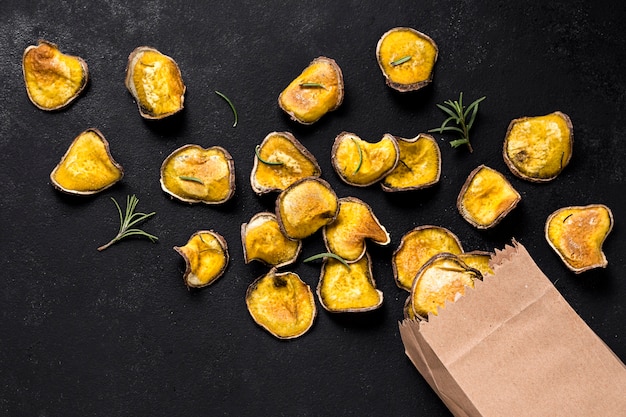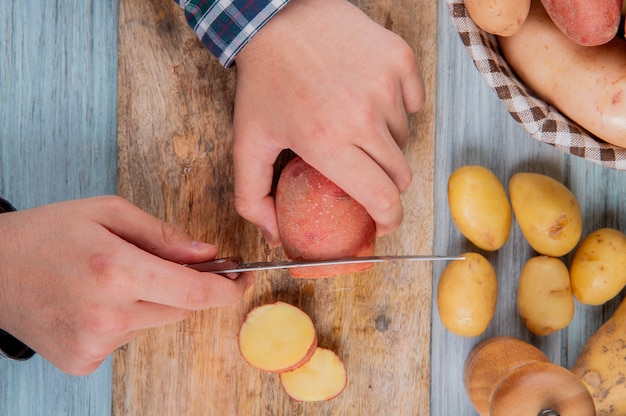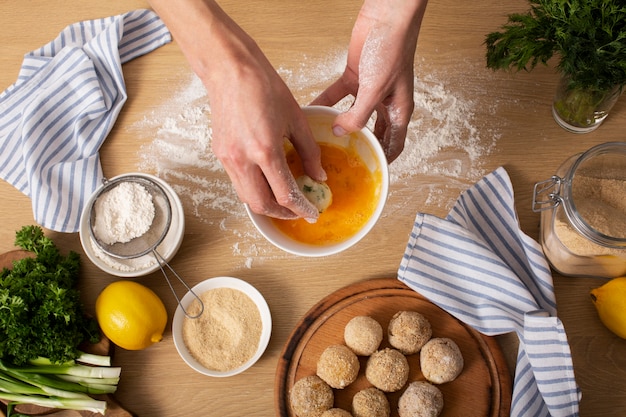(Part 1) choosing the right potatoes

The first step in any baking adventure, especially when it comes to potatoes, is choosing the right ingredients. Not all potatoes are created equal, and some are simply meant to shine in the oven, while others are destined for boiling or mashing.
The Potato Powerhouse: maris piper
For a truly exceptional baked potato experience, I'm a firm believer in the Maris Piper. This starchy powerhouse is a true gem in the potato world, known for its fluffy insides, excellent flavour, and its ability to hold its shape even after baking. The Maris Piper is a bit of a treat, a little pricier than other varieties, but trust me, it's worth every penny. The texture is heavenly, and the flavour is deeply satisfying - a true potato lover's delight.
Other Excellent Options
Now, if you're unable to get your hands on a Maris Piper, don't fret! There are plenty of other stellar potato varieties that will bake up beautifully, each with its own unique character.
- king edward: Another high-starch potato, known for its buttery flavour and excellent keeping quality. They're a bit like the Maris Piper's close cousin, with a slightly less intense flavour but still incredibly delicious when baked.
- Desiree: This potato is a bit of a chameleon, with a slightly waxy texture and a subtle sweetness that makes it perfect for roasting or baking. It's a bit more versatile than the high-starch varieties, and its sweetness adds a lovely touch to any dish.
- British Queen: Here's a potato that's a true all-rounder. It boasts a high starch content and a creamy texture, making it ideal for baking, roasting, or even mashing. It's a great option for those who like a bit of everything and want a reliable potato that consistently delivers.
Experimenting with other varieties like Nicola or Rooster can also be fun. Just remember to avoid potatoes with a high moisture content, like those intended for boiling, as they tend to become soggy when baked.
(Part 2) Preparing the Potatoes for Baking

Scrub a Dub Dub
Now that you've chosen your perfect potatoes, it's time to give them a good scrub. Wash them thoroughly under cold running water, removing any dirt, debris, or stubborn patches of soil. Use a vegetable brush or your hands, and don't be afraid to get a little vigorous with it. A good scrub is essential for ensuring a clean and delicious potato experience.
The Great Debate: To Peel or Not to Peel?
Ah, the eternal dilemma! Peel or leave the skin on? It's a matter of personal preference, but I'm a firm believer in leaving the skin on. It adds a lovely earthy flavour and a delightful crunch, and it helps to keep the potato moist during baking.
If you're adamant about peeling your potatoes, use a sharp knife and try to keep the skin intact as much as possible. A bit of skin left on won't hurt and adds a bit of rustic charm. Plus, you'll save yourself some time and effort!
Prick the Potato
Now, this is where things get serious. Before you pop those potatoes into the oven, grab a fork and give them a good pricking. Prick them all over, ensuring that you pierce the skin deeply. This is crucial for allowing steam to escape during baking, preventing a messy explosion in your oven (believe me, it happens!).
Pricking also helps to ensure even cooking. As the steam escapes, it creates little pockets of air inside the potato, allowing heat to penetrate more evenly.
(Part 3) The Art of Baking

Setting the Stage: Oven Temperature
Preheat your oven to 200°C (400°F). A hot oven is essential for achieving that crispy skin and fluffy insides. Give your oven at least 15 minutes to reach the desired temperature - it's worth the wait.
The Baking Time
Now, this is where things get a little more nuanced. The baking time will depend on the size of your potatoes and the quirks of your oven. For medium-sized potatoes, it's typically around 45-60 minutes. But don't just blindly follow these guidelines! Keep a close eye on those potatoes. You can check if they're cooked through by piercing them with a fork. If it goes in easily and the potato feels soft, it's ready.
The Finishing Touch: Roasting
After your potatoes are cooked, I love to give them a little extra roast in the oven. This elevates the flavour and gives them that beautiful golden-brown colour. Simply turn the oven up to 220°C (425°F) and roast those beauties for another 10-15 minutes, or until they're nicely browned and glistening.
(Part 4) The Deliciousness of Baking Potatoes
Versatile Goodness
baked potatoes are like culinary chameleons, adaptable to any situation. They make a delicious and comforting meal on their own, especially when adorned with a generous dollop of butter, a swirl of sour cream, and a sprinkle of fresh chives. But they also pair beautifully with an array of other ingredients, from hearty stews to vibrant salads and perfectly grilled meats. The possibilities are truly endless.
Topping It Off
Now, let's talk toppings, because this is where you can unleash your creativity! Here are a few of my personal favorites that never fail to impress:
- Classic: The tried and true combination - butter, sour cream, chives, and a generous pinch of salt and pepper. Simple, satisfying, and always a crowd-pleaser.
- Cheese Lover's Delight: For those who adore cheese, a sprinkle of sharp cheddar cheese, a few crispy bacon bits, and a dollop of creamy sour cream. This topping is pure indulgence and always a hit.
- Spicy Kick: A touch of adventure! Chili con carne, guacamole, and salsa. This combination delivers a delightful punch of flavor and heat.
- Mediterranean Flair: For a taste of the sun-kissed Mediterranean, crumble some feta cheese, add some briny olives, juicy cherry tomatoes, and a medley of fresh herbs. This topping is light, refreshing, and bursting with flavour.
Baked potatoes are a blank canvas, ready for your culinary masterpiece. Whether you're craving something creamy, spicy, or light and healthy, there's a topping combination to suit every palate and preference.
(Part 5) The Science Behind Baking Potatoes
Starch Power
The high starch content of potatoes is the secret behind their fluffy texture when baked. When potatoes are heated, the starch granules absorb water and swell, a process called gelatinization. This swelling is what gives the inside of a baked potato its signature soft and pillowy texture.
The Importance of Steam
Steam is the unsung hero of potato baking. As the potatoes heat up, the moisture inside transforms into steam. This steam plays a crucial role in cooking the potatoes evenly and preventing them from drying out.
The Maillard Reaction
That beautiful golden-brown colour on the outside of a baked potato? That's the magic of the Maillard reaction. This complex chemical reaction occurs when sugars and amino acids in the potato's skin react with heat. The result is hundreds of different flavour compounds that create the irresistible aroma and depth of flavour we love in baked potatoes.
(Part 6) Baking Potatoes: From Beginner to Pro
Top Tips for Success
Over the years, I've learned a few tricks that help me achieve that perfect baked potato, every single time. Here's a little dose of wisdom to help you on your potato baking journey:
- Don't overcrowd the oven: Give your potatoes some breathing room to cook evenly. Avoid cramming them onto the baking sheet - they need space to breathe!
- Use a baking sheet: This ensures even heat distribution and prevents those potatoes from sticking to the oven rack. It's a simple but essential step for a seamless baking experience.
- Don't overbake: You want those potatoes to be fluffy and moist, not dry and crumbly. Keep a close eye on them and take them out of the oven when they're cooked through.
- Let them cool: Allow the potatoes to cool slightly before cutting into them. This gives the starch time to set, preventing the potato from becoming mushy.
Troubleshooting: Common Pitfalls
We've all been there, haven't we? Those baking mishaps that leave us wondering what went wrong. But don't despair! With a little bit of knowledge, you can avoid these pitfalls and emerge victorious with perfect baked potatoes. Here are some common problems and their solutions:
| Problem | Solution |
|---|---|
| Potatoes are too dry | Use a lower oven temperature and/or bake for a shorter time. |
| Potatoes are too mushy | Check for over-baking. Let the potatoes cool slightly before cutting into them. |
| Potatoes are unevenly cooked | Ensure the potatoes are evenly spaced on the baking sheet and rotate them halfway through baking. |
| Potatoes are not crispy enough | Increase the oven temperature and/or bake for a longer time. |
| Potatoes are exploding in the oven | Make sure you prick the potatoes with a fork before baking. |
(Part 7) Beyond the Basics: Exploring Different Techniques
The Magic of Foil
Wrapping potatoes in foil before baking can create a lovely, soft texture. The steam generated inside the foil traps heat and moisture, resulting in a perfectly steamed potato. This method is ideal for those who prefer a more tender texture.
The Crispy Crust: Baking in a Pan of Water
For a super-crispy skin that's both satisfying and delicious, try baking your potatoes in a pan of water. The steam generated in the pan helps to cook the potatoes from the inside out, while the heat from the oven creates a lovely, crispy crust. This method is perfect for those who crave that extra crunch.
The Low and Slow Approach
If you're not in a rush and want to savor the process, you can bake your potatoes at a lower temperature for a longer period. This results in a more tender and evenly cooked potato. This method is ideal for those who want to maximize flavour and achieve a perfectly even texture.
(Part 8) FAQs
1. Can I bake potatoes in the microwave?
Yes, you can bake potatoes in the microwave, but it won't achieve the same crispy skin as those baked in the oven. It's a quick and easy option, but it won't provide that classic baked potato experience.
2. How do I reheat baked potatoes?
The best way to reheat baked potatoes is to wrap them in foil and bake them in a preheated oven at 180°C (350°F) for about 15 minutes, or until heated through. This method ensures that the potatoes stay moist and fluffy.
3. How long can I store baked potatoes?
Baked potatoes can be stored in the refrigerator for up to 3 days. Simply wrap them in plastic wrap or aluminum foil. To reheat, bake them in the oven or microwave.
4. What are some other ways to cook potatoes?
There are many other delicious ways to cook potatoes, including boiling, roasting, frying, and mashing. Each method produces a unique texture and flavour, offering a wide range of culinary possibilities.
5. What are some healthy potato recipes?
There are countless healthy potato recipes out there. Try roasted potatoes with herbs and spices, or a refreshing potato salad with Greek yogurt and vegetables.
The Final Word
And there you have it, my friends! The ultimate guide to baking perfect potatoes. With a little knowledge and practice, you can master the art of potato baking and create delicious, satisfying potatoes that will impress even the most discerning palate. So get out there, experiment, and enjoy the journey!
Everyone is watching

Corn on the Cob: The Ultimate Guide to Perfectly Cooked Ears
Healthy MealsAh, corn on the cob. Just the name evokes images of sunny days, barbecues, and that sweet, juicy flavour that ...

Perfect Pork Roast Oven Cooking Time: A Guide to Delicious Results
Healthy MealsThere's something truly satisfying about a perfectly roasted pork. The aroma alone is enough to make your mout...

Ham Cooking Time: How Long to Bake, Smoke, or Boil a Delicious Ham
Healthy MealsAh, ham. It's a classic, isn't it? A real crowd-pleaser, especially around holidays. And when done right, it'...

Scallops: The Ultimate Guide to Perfect Cooking
Healthy MealsAh, scallops. Those delicate, sweet, and utterly delicious morsels of the sea. They hold a special place in my...

Spaghetti Squash: The Ultimate Guide to Cooking and Serving
Healthy MealsRemember that time you saw spaghetti squash at the supermarket, looking all bumpy and strange, and thought, "W...
